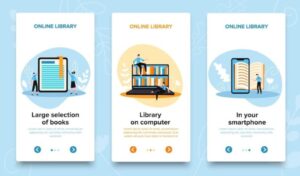Six Leading UI Design Trends To Follow In 2022

The purpose of a website’s design is to guide users through your site and have them accomplish their goals quickly. This means that designers must pay close attention to the evolution of web-user behavior, in order to best meet the ever-changing needs of this diverse group.
The design of user interfaces is one of the most difficult areas to innovate. Not only are UI Design trends constantly being analyzed by different people, but there are few real changes that impact how apps are designed. However, given that mobile app usage increased significantly in recent years, it’s clear that’s something that needs to change on the interface front.
Top UI Design Trends of 2022
In this article, we will share the top six UI Design trends that have to become part of your UIs in the near future. If you want to stay competitive and integrate next year’s user interface trends into a new app or a website, scroll down!
-
Emotional Design
AI and emotional intelligence (EI) has been a growing trend not only in technology but also in user interfaces. It is important to think about emotions because people tend to share their experiences with other people. We can create better interactions by understanding what users say or do and why they behave that way instead of just focusing on functionalities alone which do not represent how real life works where we have emotions & feelings attached to our actions such as getting frustrated while searching for something, happy when getting what we want, sad when something is missing in our UIs.
This is perhaps one of the most significant UI design trends to have emerged in the last few years. With so much talk about AI and bots, it is not shocking that this trend has materialized. The concept behind emotional design simply refers to creating interfaces that are capable of evoking emotions from their users. Although this might seem meaningless at first glance, there have been many studies done over time to highlight how engaging an interface can help drive more traffic and lead generation for a business or brand.
-
Metaverse
‘Metaverse’ refers to a virtual world or universe that people can escape into through immersion using advanced VR (virtual reality) technology. As well as designing these 3D immersive environments online, it’s also expected that a lot of companies will begin designing AR experiences. This makes it possible for companies to create an enhanced version of their website by adding elements from the metaverse directly onto your computer or mobile screen.
Imagine a world where everyone can appear in public without hesitation because you know your identity isn’t attached to the online profile you’re currently using because it’s not real. This is possible when someone creates their own avatar that represents them in virtual worlds. We are used to this concept from games like Second Life or anime series like Sword Art Online but now imagine the real world working the same way. It will likely happen sooner than expected with companies making progress in facial recognition & 3D scanning technologies allowing us to create an avatar similar to how we look today and have it used across all devices connected to each other through the Internet of Things (IoT).
-
Mobile-first Approach
Nowadays, most of us use mobile devices (smartphones or tablets). The number of people owning smart devices is steadily growing, so it’s no surprise that more and more companies launch mobile apps first. This approach allows creating simple navigation and quick solutions to user problems. People can find information on their own time and in their own space.
As mobile technology continues to grow exponentially it has also become extremely powerful in recent years. There are now phones worth $1,000 USD with more storage than computers had just a decade ago so companies have started rethinking their design process to take advantage of this new power. As more businesses adopt a mobile-first approach, there will be less focus on the desktop experience because browsers are getting better at running large-scale websites.
-
Voice User Interface (VUI)
Imagine having your phone at home speak with you about your day while you’re cooking dinner? That would be amazing right? Well, imagine telling your phone what items you need at the grocery store. All of this is possible with Voice User Interface (VUI). VUI is voice-based interaction with computing devices. This trend in user interfaces will only grow in the next 5 years with an estimated 90% of all interactions with technology being carried out solely by voice within 10 years. It’s important for designers to understand how touch screens have changed the way we structure/curate content and that voice may be doing the same thing, but without touching anything.
Voice UI will be powering the next generation of digital products. We can see a number of new Artificial Intelligence (AI) powered voice-enabled devices, such as speaker boxes and headphones, hitting the market in early 2018. While many people were skeptical about this new technology thinking it has no place in the everyday household, they might not realize that the voice interface will become part of our daily lives sooner than we think. Apple acquired VocalIQ, a startup that had been working on natural language technology for cars and smart homes, and Google Assistant conversational AI was hailed by WIRED magazine as “the future of computing”.
-
Dynamic Color Palettes
We are going to see dynamic color palettes more often. There are already some websites using motion design to change the background colors of certain elements based on user behavior or time of day. Also, smartwatches have been utilizing colorful moving graphics for years now, so this trend isn’t really new per se. However, there is a high chance that we will see more of these kinds of changes in the near future across all platforms including smartphones, desktop computers, or even car dashboards! It’s important that UX designers keep an eye out for this upcoming trend and study how to implement it into their own designs.
As apps adopt more native features, they are also evolving their design styles. One key aspect of mobile UI design has been incorporating visuals into everyday experiences – something people are beginning to expect on every device they use. For example, designers are creating color palettes that dynamically shift in response to the surrounding environment or mood.
AI will continue to change how we interface with the world, color palettes will continue to change as well. AI is able to take whatever emotion you’re feeling and find colors that match that mood. For example, if someone is stressed out or excited then the AI can pick colors that are either calming or energetic to heighten an emotional response through color.
-
Simplify Navigation
The interface will continue to get simpler, with fewer clickable options displayed at once. In fact, more elements may be moved off-screen entirely within mobile-friendly websites created with responsive web design technology. This isn’t because designers want users to have a difficult time navigating their sites; it’s simply because there’s too much data available today for users to process. As a result, the web is full of information overload, which leads to analysis paralysis.
Navigation is going to be simplified across all devices – whether if it’s a smartphone, tablet, laptop, or desktop computer – there should be only one clear entry point for users. The rise of voice-controlled devices like Amazon Echo (based on Siri), Google Home (based on OK Google), and Viv (based on SIRI) increase the importance of simple navigation across devices as well as simplifying it. As such, now more than ever before, it’s important for designers to learn about conversational UI design and make sure they use conversational language patterns in their interfaces.
Conclusion
There is no denying that technology has changed our lives, and will continue to do so in the future with emerging technologies like virtual reality, Artificial Intelligence, machine learning, etc. The way we see technology today is already changing rapidly just within the last few years, which hints at what is still to come by 2022. So let’s take a look into the future and see what UI design trends might emerge over the next four seasons.
You can be sure that your website will look professional and operate well with the help of our team at Pixel Street – A Web Design Company. We provide high-quality standards throughout every step from initial consultations up until providing clients with fully customized sites for affordable prices!
Author Bio:
Khurshid Alam is the founder of Pixel Street, a web design company. He aspires to solve business problems by communicating effectively digitally. In his leisure, he reads, writes, and occasionally plays a game of table tennis.







